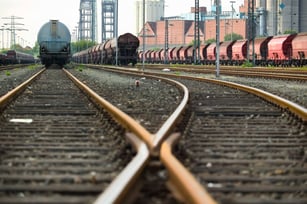 Implementing the right rail safety solution is critical to protecting your workers from serious accidents that may cause injuries or fatalities. While these consequences are reason enough to improve workplace safety, failing to take proper rail safety precautions may also negatively impact your bottom line, lead to legal ramifications or result in fines from OSHA.
Implementing the right rail safety solution is critical to protecting your workers from serious accidents that may cause injuries or fatalities. While these consequences are reason enough to improve workplace safety, failing to take proper rail safety precautions may also negatively impact your bottom line, lead to legal ramifications or result in fines from OSHA.Fall prevention equipment is beneficial for companies that need a way to safely access rail cars. With a wide variety of rail car types and hatch configurations, your safety equipment must be designed to accommodate your facility and processes.
There’s no one-size-fits-all rail safety solution, which is why it’s so important to work with a trusted vendor that can help you develop a custom solution for your site.
Here are four crucial design considerations for your rail safety solution:
1. Your Current Safety Concerns
Before you begin working with a vendor, it’s important to understand the conditions at your work site and the dangers your workers face. Rail safety solutions are designed to help prevent falls, but you must analyze where your employees are at risk of falling before you’re able to design a truly effective solution.
The right vendor should ask you questions about your work site to gain a deep understanding of your business’s needs. This will help your vendor design rail safety solutions that address the dangers of your specific facility. When your vendor makes guesses as to what the intended use is, you’re likely to end up with the wrong equipment.
2. The Parameters Of Your Work Site
Before you design a custom safety solution, you need to analyze the area where your equipment will be used. This gives both you and your vendor a better idea of the right solutions for your work site.
For example, after analyzing your site, you may find that your employees need a way to safely load and unload rail cars. Before developing custom fall prevention equipment, your vendor will take into consideration whether cars are coupled or uncoupled and how much space you have available.
3. Your Business’s Future Needs
When designing rail safety solutions, consider what you have planned for the future or opportunities that may come your way. This holds true for both process and equipment changes.
Perhaps you’re planning to increase the amount of products being loaded in one spot or change your fleet in the next year. It’s often costly to incorporate new parameters after you’ve already purchased equipment, so communicate these potential changes with your vendor upfront.
4. Evolutionary Changes Of Regulations
Safety regulations are constantly in flux, and it’s important to consider the evolutionary changes of these regulations when designing safety equipment. Companies are being cited for actions they never were previously, especially when it comes to the lack of fall protection altogether.
Additionally, a new amendment signed into law in 2015 raises OSHA fines by approximately 80 percent. This is just another reason to be mindful of evolving regulatory changes.
Although there’s no way to predict future regulations from OSHA, being forward-thinking is wise. Instead of implementing rail safety solutions designed solely for your needs now, ask yourself, “What will be most beneficial for my business in the years to come?”
Implementing the proper fall prevention equipment is the best way to minimize the risk of accidents and keep your employees out of harm’s way. By working with an experienced vendor, your work site will benefit from rail safety solutions designed for your specific concerns.
To learn more about comprehensive rail safety solutions, download this free industry guide from Carbis Solutions.




